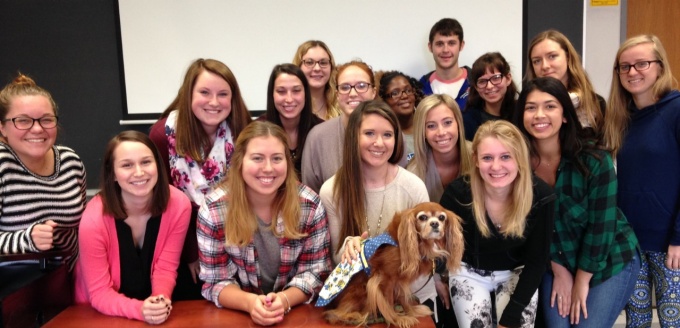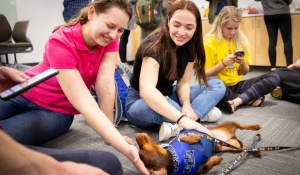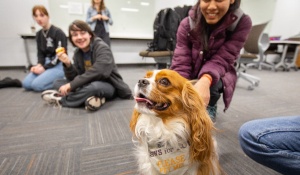Exploring the Human-Animal Connection Through Social Work
Adjunct instructor Day Cummings' dog Isabella visits her MSW students at UB, and she says, "I find it very beneficial for her to come to class, especially when discussing trauma. Bringing her relaxes the students and offers them an outlet at times when it is needed the most."
by Jana Eisenberg
More and more schools of social work are teaching about and examining the relationship between humans and animals, and how those relationships might be beneficial in the practice of social work.
From Colorado to New Jersey, over 15 universities in the U.S. have some sort of program, certificate, course or ongoing research, exploring the various ways that social work educators, students and practitioners who are interested in animals can mesh that interest with their practice—and be of service and value to their clients at the same time.
A growing specialty within the area is the use of therapy animals in a wide variety of environments, such as private practice, nursing homes, schools, courtrooms and mental health centers. Another natural offshoot is the increasing presence of social workers within veterinary practices, to provide an emotional connection and other services to people with pets across the spectrum of care they’re seeking for their companion animals.
Providing social lubricant, and easing the minds of pet-owners
UB libraries host Stress Relief Days during the last week of classes each semester.
After earning her degree at UBSSW, Roberta Thompson, MSW ‘08, pursued her love of animals at one of the more well-known of these programs, and holds a post-graduate certificate from University of Denver Graduate School of Social Work in the animal-human bond.
“When I was at UB, there was not much acceptance for animal-assisted therapy; I was told that there was no evidence-based research and studies,” said Thompson. “At Denver now, they have an endowed chair to study and promote the human-animal bond, and animal assisted-therapy is becoming more accepted and common.
Her work, at Chautauqua Hospice and Palliative Care in Chautauqua County, NY, finds her facilitating animal-assisted therapy. “As part of the therapeutic services offered at Chautauqua Hospice and Palliative Care, I was asked to start a program of pet therapy,” said Thompson. “The goals with the animals in the hospice program include socialization and overcoming depression. When we go to visit a patient, what I find is typically, the animal serves as a social lubricant; the patient will begin to talk to or about the animal, and volunteer all sorts of information.”
With funding from the Banfield Charitable Trust, Thompson also founded a chapter of Pet Peace of Mind at the hospice. The national program recognizes the importance of pets to patients/humans, and helps them plan for their pet’s care when they are going to hospice. That plan may involve being able to keep their pet or making sure that the animal is cared for. “Pets are family, sometimes people’s only family. When you think about giving them up, that can be a profound loss,” said Thompson. “Some people will even avoid taking care of themselves if they are not clear about what will happen to their pet.”
A calming presence, building trust
Another UB end-of-the-semester Libraries Stress Relief event featuring the SPCA Paws for Love program.
Day Cummings, MSW ‘02, also employs animals in her practice. She founded the animal-assisted therapy program at BestSelf’s Child Advocacy Center (CAC). She attested to the simple reason that animals can be effective in therapeutic settings: “Animals are comforting to both kids and adults; when people are anxious or stressed, animals can have a calming effect.”
In social work, one of the most important things is being able to connect and engage with clients. “In my private practice, I have clients who say they’re coming to see my dog, Isabella, not me,” said Cummings. “Animals can help build trust, too. Isabella is a helper; they are talking to me through her. People are often more relaxed when animals are around, and having one in the room can also give purpose and focus.”
Dogs are the most commonly used therapeutic animal; Cummings said that they are brought in for both individual and group work at CAC, as well as to accompany children testifying in court. “I have seen a child in a courtroom, with a Labrador at their side for two days of testimony; the dog was so calm, no matter what happened in that room. It was amazing to watch. The child just touched the dog constantly, feeling the warmth,” she said.
In therapy with both kids and adults, added Cummings, having an animal nearby or in their lap can ease them into the process. “Because the animals are an accepting and non-judgmental presence there, kids have a tendency to tell the therapy animal what’s going on rather than the counselor,” she said. “The animals like you no matter what.
Easing the way for both families and veterinary staff
Alyssa Pepe (middle), MSW '14, with Eric Kancar (left), Licensed Veterinary Technician, and client (right), at the Orchard Park Veterinary Medical Center, where she is a veterinary social worker.
Like many others drawn to this area of social work, Alyssa Pepe, MSW ‘14, always had a strong love of animals, and they had always been part of her life. Pepe is now a veterinary social worker at the Orchard Park Veterinary Medical Center. She also volunteers for the SPCA Serving Erie County in the wildlife department. (See sidebar p. 6 for a deeper look at her work.)
“In grad school I learned about the ability to blend social work and animals, though there weren’t a lot of open positions,” said Pepe. She worked for a time in mental health before finding her current job. “Social work is a helping profession,” said Pepe. “It came naturally to be able to combine working that with helping pet owners through the grief and loss process. Bringing in my understanding of that was very powerful.”
The four major areas of veterinary social work are delineated as: compassion fatigue, conflict management, animal-related grief and bereavement, and the link between animal and human violence.
“I do a lot of work with families coming in with their pets for euthanasia or quality of life discussions,” said Pepe. “And I help the veterinary staff develop self-care and compassion techniques to avoid burn out and moral distress. They experience job difficulties. They might not be in agreement with the client; or they’re explaining difficult things like euthanasia. We work on training staff to recognize signs of animal abuse. I also try to help them understand where the clients might be coming from.”
Pepe noted that animals can actually be the therapy and provide a spiritual connection for people. “Last spring and summer I started volunteering in the SPCA Serving Erie County wildlife department; I was caring for baby birds in the bird nursery,” she said. “I found it grounding, and it also put me in tune with the human and animal relationship in a very different way. The experience motivated me to keep helping and promoting the importance of all animals in our lives.



